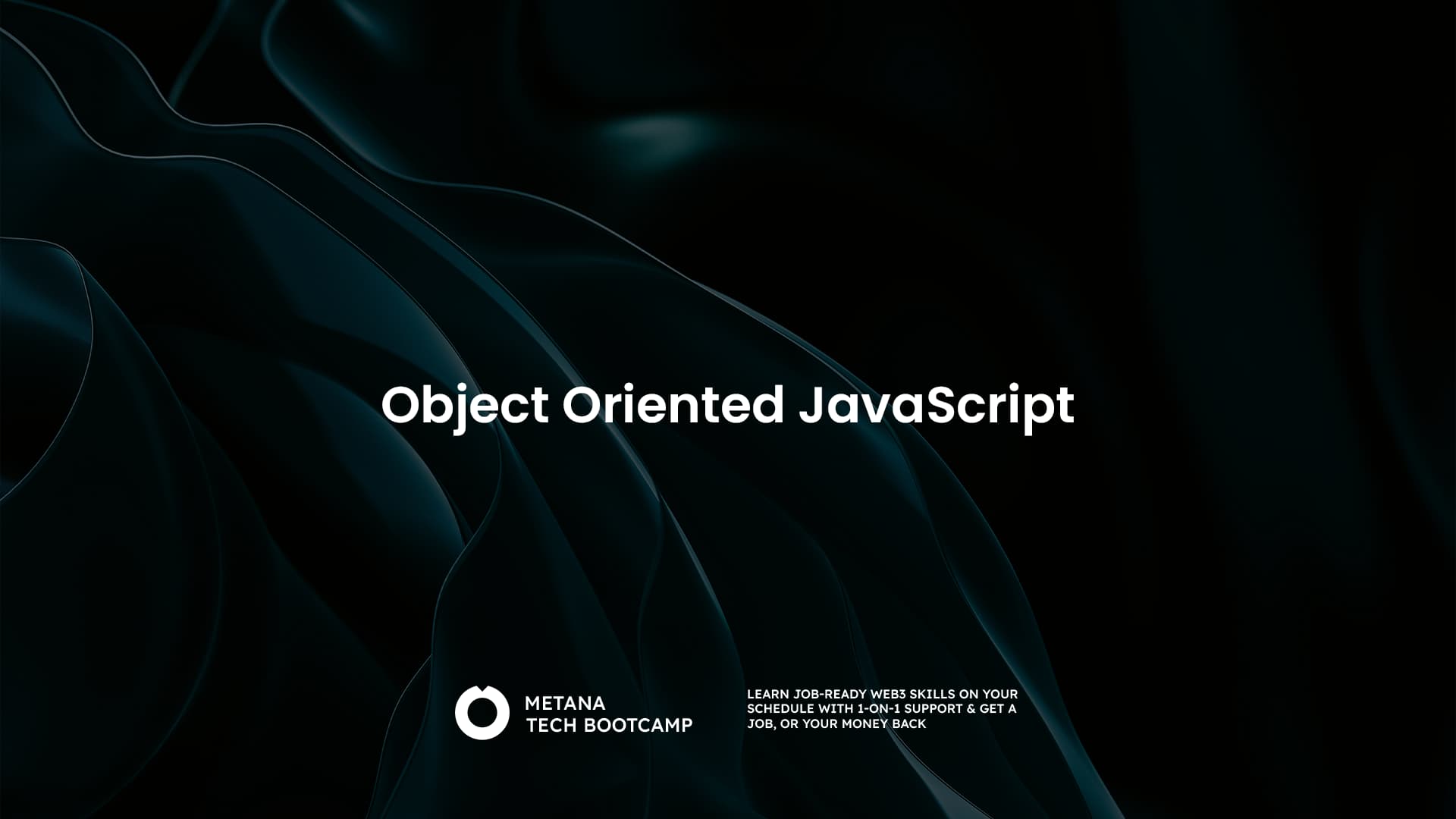TL;DR:
- JavaScript utilizes a prototype-based inheritance model, differing from class-based languages.
- Key OOP concepts in JavaScript include objects, classes (introduced in ES6), properties, methods, inheritance, encapsulation, and polymorphism.
- Encapsulation is achieved through conventions like prefixing private properties with an underscore and using getter and setter methods for controlled access.
- Polymorphism allows objects of different classes to respond to the same method call in distinct ways, enabling flexible interactions.
- Understanding these concepts enhances modularity, code reusability, and dynamic interactions in JavaScript applications.
JavaScript (JS), the popular language of web development, has a unique relationship with object-oriented programming (OOP). In contrast to class-based languages like Java or C++, JavaScript leverages a prototype-based inheritance model. This article will explain everything about Object-Oriented JavaScript, exploring core concepts, practical applications, and best practices.
What is OOP?
Object-oriented programming is a model for software development centered around objects. These objects encapsulate data (properties) and the actions they can perform (methods). Imagine a car: its properties include color, model, and horsepower, while its methods include driving, braking, and turning. Objects interact with each other through method calls, fostering modularity and code reusability.
Here’s a breakdown of key OOP concepts relevant to JS:
- Objects: Fundamental entities that hold properties and methods. Objects are created using object literals ({}) or constructor functions.
- Classes (ECMAScript 2015+): Blueprints that define the properties and methods shared by objects of a particular type. Classes offer a more concise way to write code that achieves the same results as the underlying prototype-based system.
- Properties: Data attributes associated with an object. They represent the object’s characteristics.
- Methods: Functions attached to objects that define their behavior. Methods operate on the object’s data.
- Inheritance: Mechanism for creating new objects (subclasses) that inherit properties and methods from existing objects (superclasses). This promotes code reuse and simplifies complex hierarchies.
- Encapsulation: Practice of bundling data and methods together within an object, potentially restricting direct access to internal properties. This promotes data integrity and controlled modification.
- Polymorphism: Ability of objects of different classes to respond to the same method call in distinct ways. This allows for flexible and dynamic interactions.
While JavaScript doesn’t strictly adhere to class-based OOP, it achieves similar functionality through prototypes.

Prototypes
In JS, objects are linked together through a prototype chain. Each object has an internal hidden property called [[Prototype]] (prototype) that points to another object. This prototype object serves as a blueprint, containing properties and methods that the original object inherits. When a property or method is accessed on an object, JS first searches within the object itself. If not found, it traverses the prototype chain, looking for the property or method in the prototype object and any further prototypes in the chain.
Here’s a simplified example:
function Person(name, age) {
this.name = name;
this.age = age;
}
Person.prototype.greet = function() {
console.log("Hello, my name is " + this.name);
};
const person1 = new Person("Alice", 30);
person1.greet(); // Outputs: "Hello, my name is Alice"In this example, Person is a constructor function that creates Person objects. The greet method is defined on the Person.prototype object, making it accessible to all Person instances like person1.
Classes in JavaScript
ECMAScript 2015 (ES6) introduced the class keyword, providing a more familiar syntax for those accustomed to class-based OOP. While classes in JavaScript offer a convenient way to write code, it’s essential to understand that they ultimately translate to prototype-based inheritance. Under the hood, they still make use of the prototype chain.
Here’s the previous example rewritten using a class:
class Person {
constructor(name, age) {
this.name = name;
this.age = age;
}
greet() {
console.log("Hello, my name is " + this.name);
}
}
const person1 = new Person("Alice", 30);
person1.greet(); // Outputs: "Hello, my name is Alice"Both approaches achieve the same result. Classes offer a cleaner syntax for defining object properties and methods, making code more readable and maintainable, especially for developers coming from class-based languages.
Inheritance
Inheritance allows you to create new object types (subclasses) that inherit properties and methods from existing object types (superclasses). This promotes code reuse and simplifies the creation of object hierarchies.
Here’s how inheritance works in JS:
class Person {
constructor(name, age) {
this.name = name;
this.age = age;
}
}
class Employee extends Person {
constructor(name, age, salary) {
super(name, age); // Call superclass constructor
this.salary = salary;
}
}
// Usage
const employee1 = new Employee("Bob", 30, 50000);
console.log(employee1.name, employee1.age, employee1.salary); // Outputs: "Bob 30 50000"This code snippet demonstrates inheritance in JS. Let’s break it down:
- Person Class: This class defines the basic properties (
nameandage) for allPersonobjects. - Employee Class: This class inherits from the
Personclass using theextendskeyword. It adds a new property(salary)specific to employees. - Employee Constructor: The
Employeeconstructor calls thesuperconstructor (super(name, age))to initialize the inherited properties fromPerson. Then, it assigns thesalaryproperty.
Now, you can create Employee objects that inherit properties from Person (like name and age) and add their own property (salary).
Encapsulation
Encapsulation refers to the practice of bundling data (properties) and methods together within an object, potentially restricting direct access to internal properties. Imagine an object in your code as a box. This box holds both the data (like a value) and the instructions for working with that data (like methods). Encapsulation is like putting a lock on that box. You can still access the data and use the instructions, but you can’t directly mess with the inner workings. This promotes data integrity and controlled modification.
JS doesn’t have strict mechanisms for enforcing encapsulation like private properties in other languages. However, there are conventions to achieve a similar effect:
- Variable Naming: Use private member variables by prefixing them with an underscore (_). This discourages direct modification from outside the object.
- Getter and Setter Methods: Define methods to access and modify private properties. These methods can perform validation or additional logic before retrieving or setting the value.
Here’s an example:
class Car {
constructor(model) {
this._model = model; // Private property
}
get model() {
return this._model;
}
set model(newModel) {
if (newModel.length < 3) {
throw new Error("Model name must be at least 3 characters long");
}
this._model = newModel;
}
}
const car1 = new Car("Camaro");
console.log(car1.model); // Outputs: "Camaro"
// Attempting to directly modify _model throws an error
car1._model = "Short"; // throws ErrorIn this example, the _model property is private. The model getter and setter methods provide controlled access and validation for the model name.
Polymorphism
Polymorphism allows objects of different classes to respond to the same method call in distinct ways. Imagine you’re a spy and you have a special device that lets you disguise yourself. When someone calls out “Show your ID,” you might respond with your agent ID if you’re undercover as a government official, or with your student ID if you’re posing as a college student.
Polymorphism in JS works similarly. It allows objects of different classes to respond to the same method call in different ways, depending on their type. This is like the spy’s device – the same “show ID” call gets a different response based on the object’s disguise (its class). This enables flexible and dynamic interactions.
Here’s a demonstration using function overriding:
class Animal {
makeSound() {
console.log("Generic animal sound");
}
}
class Dog extends Animal {
makeSound() {
console.log("Woof!");
}
}
class Cat extends Animal {
makeSound() {
console.log("Meow!");
}
}
const animal1 = new Dog();
const animal2 = new Cat();
animal1.makeSound(); // Outputs: "Woof!"
animal2.makeSound(); // Outputs: "Meow!"In this example, the makeSound method is polymorphic. It’s defined in the base Animal class, but overridden in the Dog and Cat subclasses to produce their specific sounds. This demonstrates how polymorphism allows for a single method call to trigger different behaviors based on the object’s type.
Building Real-World Applications
Object-oriented principles empower you to structure complex applications in JS. Here’s an example of a simple e-commerce application using these concepts:
class Product {
constructor(name, price, quantity) {
this.name = name;
this.price = price;
this.quantity = quantity;
}
calculateTotal() {
return this.price * this.quantity;
}
}
class Cart {
constructor(items = []) {
this.items = items;
}
addItem(product) {
this.items.push(product);
}
removeItem(product) {
const index = this.items.findIndex(item => item === product);
if (index > -1) {
this.items.splice(index, 1);
}
}
getTotalCost() {
let total = 0;
for (const item of this.items) {
total += item.calculateTotal();
}
return total;
}
}
const product1 = new Product("T-Shirt", 20, 2);
const product2 = new Product("Jeans", 50, 1);
const cart = new Cart();
cart.addItem(product1);
cart.addItem(product2);
console.log(cart.getTotalCost()); // Outputs: 90 (20 * 2 + 50 * 1)
cart.removeItem(product2);
console.log(cart.getTotalCost()); // Outputs: 40 (20 * 2)This example demonstrates:
- Product Class: Represents a product with properties like name, price, and quantity. It includes a calculateTotal method.
- Cart Class: Manages a collection of products. It provides methods to add, remove, and calculate the total cost of items in the cart.
This is a simplified example, but it showcases how objects can encapsulate data and functionalities relevant to specific entities in your application.
Best Practices for Effective OOP in JavaScript
Here are some best practices to keep in mind when using OOP in JavaScript:
- Favor Composition over Inheritance: While inheritance can be useful, relying heavily on it can lead to complex hierarchies and tight coupling. Consider using composition, where objects delegate tasks to other objects, to achieve code reusability and maintainability.
- Use Classes Judiciously (ES6+): While classes offer cleaner syntax, remember that JS functions as a prototype-based language at its core. Don’t overuse classes if simpler object literals or functions suffice.
- Focus on Object Responsibility: Each object should have a clear and well-defined purpose. Avoid creating “god objects” that handle too much logic.
- Document Your Code: Use comments to explain the purpose of classes, methods, and properties. This enhances code readability and maintainability for yourself and others.
- Test Your Code: Write unit tests to ensure your objects behave as expected. This helps catch bugs early in the development process.
By following these best practices, you can make use of the power of OOP to write cleaner, more maintainable, and scalable JavaScript applications.
Conclusion
Object-Oriented JavaScript offers a powerful approach to structuring complex applications. While it differs from class-based languages, understanding prototypes and effectively applying OOP principles can significantly improve your code organization, reusability, and maintainability. This guide has equipped you with the fundamental concepts, practical applications, and best practices to begin your journey with OOP in JavaScript.
Wanna Learn more about JavaScript? Check our articles on JavaScript 👇
- How JavaScript Works?
- JavaScript Varialbles
- JavaScript Operators
- JavaScript Functions
- JavaScript Arrays
- JavaScript Control Structures
FAQs
What is Object Oriented JavaScript
- Object Oriented JavaScript (OOP) is a programming paradigm that uses objects and classes to create more reusable and modular code.
How does inheritance work in JavaScript?
- In JavaScript, inheritance allows objects to inherit properties and methods from other objects, typically using prototypes or the class syntax introduced in ES6.
What are the benefits of using OOP in JavaScript?
- Using OOP in JavaScript enhances code reusability, simplifies debugging, and improves project scalability.
Can you explain polymorphism in JavaScript?
- Polymorphism in JavaScript involves using the same interface for different data types. Methods can be overwritten or objects can be handled differently based on their data type or structure.
What is the role of constructors in JavaScript classes?
- Constructors in JavaScript classes initialize new objects. They set up properties and bind methods, preparing the object for use.
What are the core principles of Object Oriented Programming?
- The core principles include encapsulation, inheritance, and polymorphism, all aimed at creating more efficient and manageable code.
How can I improve my JavaScript coding skills?
- Practice consistently, study various JavaScript projects, and participate in coding communities or forums to learn from experienced developers.
What tools are available for debugging JavaScript?
- Tools like Chrome DevTools, Firefox Developer Edition, and Visual Studio Code offer powerful debugging features for JavaScript.
Are there any popular frameworks that support OOP in JavaScript?
- Frameworks like Angular, React, and Vue.js support OOP practices, though they implement them in different ways based on their architecture.
What is the future of JavaScript development?
- The future looks robust with the ongoing evolution of ECMAScript standards, more sophisticated frameworks, and improved support for modern web development techniques.





